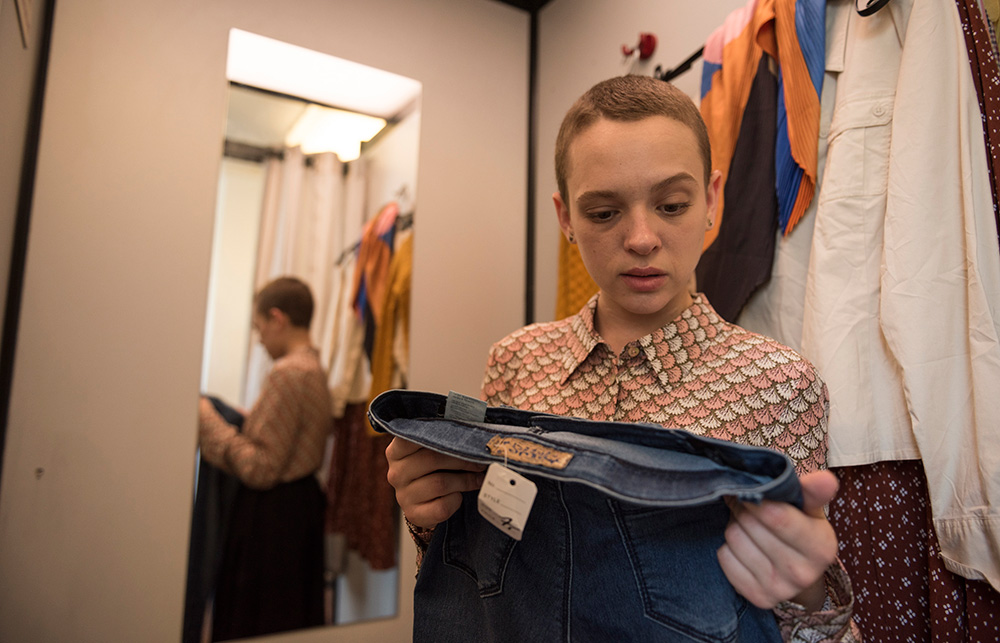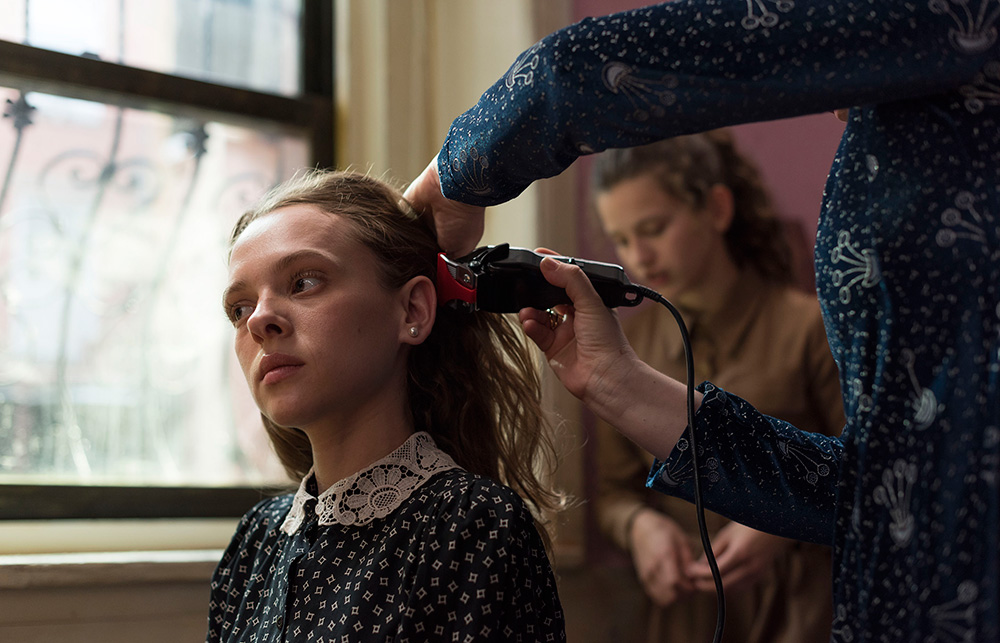獲得8項(xiàng)艾美獎(jiǎng)提名的《離經(jīng)叛道》,是怎么選角和選服裝的,?
如何把黛博拉?費(fèi)爾德曼的回憶錄《離經(jīng)叛道:逃離我的哈西德血統(tǒng)》改編成電視,,而且即使最終呈現(xiàn)出的作品只有部分基于真實(shí)事件,還是要讓它看起來(lái)盡可能真實(shí)?
《離經(jīng)叛道》的選角導(dǎo)演埃斯特?克林和服裝設(shè)計(jì)師賈斯汀?西摩在接受《財(cái)富》雜志采訪時(shí)表示,,很重要的一點(diǎn)是找到合適的演員,,認(rèn)真研究、精心做好劇組服裝設(shè)計(jì),??肆趾臀髂Χ家?yàn)槟物w(Netflix)這部限定劇中獲得了今年艾美獎(jiǎng)的提名。
該劇講了來(lái)自布魯克林威廉斯堡的哈西德派猶太教女子埃斯蒂(希拉?哈斯飾)決定離開布魯克林去柏林的故事,,因此需要在多個(gè)國(guó)家尋找合適的演員。除了要找會(huì)說(shuō)意第緒語(yǔ)的演員(意第緒語(yǔ)在影片中非常重要,,但如今會(huì)說(shuō)的人已經(jīng)不多了),,選角團(tuán)隊(duì)還需要找到能體現(xiàn)某些特點(diǎn)的演員。
主角哈斯和阿米特?拉哈夫(后者飾演埃斯蒂的丈夫揚(yáng)基)是以色列人,,他們必須得現(xiàn)學(xué)意第緒語(yǔ),。但是,盡管存在語(yǔ)言障礙,,仍然有多方面因素讓人覺得他們就是最佳人選,。
“她很好地刻畫了孩子氣和女人味之間微妙的平衡感,這個(gè)角色既堅(jiān)強(qiáng)又脆弱,,既聰明又天真,,”克林這樣評(píng)價(jià)哈斯??肆诌€說(shuō),,拉哈夫的表演很“成熟”,也表現(xiàn)出了一種和他的角色相稱的天真,。

選角導(dǎo)演還在倫敦,、德國(guó)、紐約的一家劇院和其他地方尋找演員??肆终f(shuō),,聚集的制片人也參與了進(jìn)來(lái),正是他們請(qǐng)來(lái)了耶夫?威爾布什飾演莫伊什,。
“他們希望他能在戲里演點(diǎn)什么角色……但他們不確定具體演誰(shuí),。”克林說(shuō),,“我感覺莫伊什這個(gè)角色一開始適合年紀(jì)更大的演員,,但他們?yōu)樗隽苏{(diào)整?!?/p>
西摩說(shuō),,雖然費(fèi)爾德曼的回憶錄也講述了一些周遭環(huán)境,但劇組還是在威廉斯堡做了很多實(shí)地調(diào)研,。她對(duì)薩特瑪(Satmar)社區(qū)給予了特別關(guān)注,,因?yàn)橘M(fèi)爾德曼曾經(jīng)是這個(gè)教派的一員。
“我們花了一周時(shí)間進(jìn)行社區(qū)實(shí)地調(diào)研,,逛當(dāng)?shù)厣痰?,我們進(jìn)行了一次踩點(diǎn)之旅,四處拍照,?!蔽髂Ω嬖V《財(cái)富》雜志。我們采訪了街上一些愿意接受采訪的人——有很多人不愿意,,但也有一些人對(duì)我們所做的事情非常感興趣,。商店里的工作人員都很愿意敞開心扉,給我們解釋什么是什么,?!?/p>
服裝在展示埃斯蒂的旅程中發(fā)揮了很大的作用;西摩說(shuō),,這個(gè)角色就像拼圖的中心,,圍繞她構(gòu)建了一個(gè)世界。年輕的埃斯蒂更多的是穿便裝,。后來(lái),,等她結(jié)婚了,她開始穿更有結(jié)構(gòu)感的衣服——在她結(jié)婚的第一周,,她的衣服色彩更鮮艷,,場(chǎng)景里也經(jīng)常出現(xiàn)一些亮點(diǎn),目的是強(qiáng)調(diào)她的身份發(fā)生了變化,。等埃斯蒂到了柏林,,她的穿衣風(fēng)格出現(xiàn)了變化——盡管一開始變得很慢——她開始從在這個(gè)陌生城市里遇到的其他女性那里一點(diǎn)一點(diǎn)學(xué)習(xí)積累自己的著裝風(fēng)格,。
“我和黛博拉談過(guò)她的變化,她說(shuō)這是一個(gè)非常緩慢的過(guò)程,?!蔽髂φf(shuō),“不過(guò)她喜歡穿牛仔褲,,這就是我為什么直接跳到了牛仔褲,,因?yàn)樗娴姆浅O矚g牛仔褲?!?/p>

“隨著故事的發(fā)展,,[埃斯蒂]的領(lǐng)口開低了點(diǎn),,衣服的面料更柔軟、更性感,,”她補(bǔ)充道,。
在埃斯蒂住的地方,配角(尤其是女性)的穿著也可以彰顯個(gè)性,。各種顏色和設(shè)計(jì)的頭巾起了很大作用,。西摩很快了解到,大牌頭巾非常受歡迎,,比如菲拉格慕(Ferragamo)和愛馬仕(Hermes)的頭巾,。但因?yàn)闆]有太多預(yù)算買不了那么多大牌,她給埃斯蒂的岳母米里亞姆買了幾條真的牌子貨,,給其他角色準(zhǔn)備了一些假的和二手頭巾。
香奈兒風(fēng)格的定制服裝也是米里亞姆衣櫥的一部分,,既體現(xiàn)了她在家庭中的女家長(zhǎng)角色,,也顯示出“她們家比埃斯蒂家稍微富裕一點(diǎn)?!?/p>
雖然很多衣服——尤其是男人的衣服——買的是成衣,,但西摩確實(shí)花時(shí)間做了一些服飾,包括一些女性的便服和頭巾,。埃斯蒂的婚紗是在eBay上買的,,但買回來(lái)后進(jìn)行了修改加工。
“希拉?哈斯是一位身材非常嬌小的年輕姑娘……我們買到的裙子正合我心意,,但我們還是把整條裙子拆成了幾片,,把裙擺裁掉了大約18英寸。我把腰線抬高了,?!蔽髂φf(shuō),“這么改的原因是我想讓它更有公主的感覺,也是想模仿黛博拉?費(fèi)爾德曼的風(fēng)格,?!?/p>
西摩買的什特萊牟(shtreimel)——已婚的哈西德男性在安息日和節(jié)日時(shí)戴的圓形毛皮帽子——是漢堡的一家戲劇公司制作的,部分是出于預(yù)算原因,,部分原因是為了避免購(gòu)買新的毛皮,。而且,紐約賣正宗shtreimel的商店也不會(huì)賣給她,。
她笑著說(shuō):“(這些帽子)送到時(shí),,剛從盒子里拿出來(lái)的時(shí)候,非常非常蓬松,?!彼a(bǔ)充道,后來(lái)她在帽子上涂上了厚厚的發(fā)膠,,然后一直梳,,把它們梳得更像真正的shtreimel。
西摩教演員和服裝助理們各種服裝應(yīng)該怎么穿,,她還打印了便箋,,任何人需要查閱的時(shí)候都可以用。她說(shuō):“我還會(huì)把試裝的照片夾在衣服上,,存在劇本里,,這樣,哪怕我不在場(chǎng),,他們也能清楚看到衣服應(yīng)該怎么穿,。”
這并不是演員們得到的唯一指導(dǎo)——在選角過(guò)程中,,他們就提前得知了要扮演的角色在這部劇里的重要情節(jié),。哈斯在埃斯蒂婚后的一個(gè)場(chǎng)景中剃了光頭,一些哈西德派的婦女會(huì)這么做,。

“如果演員不愿意剃光頭,,就不用試鏡了,。我們不想浪費(fèi)任何人的時(shí)間,,”克林說(shuō)。除了會(huì)告訴演員一些身體上的要求,,比如剃光頭,,或者和其他演員演親熱戲,克林說(shuō),,他們還會(huì)告訴演員故事的文化背景,,會(huì)提前告訴演員是否需要用意第緒語(yǔ)試鏡,。
克林說(shuō)這部劇有非常“特別”和“獨(dú)特”的氣質(zhì),,他也十分享受制作這部劇的過(guò)程,。
“這是一個(gè)由女性講述的關(guān)于某一個(gè)特定女性的故事,是一個(gè)人的真實(shí)經(jīng)歷,,但它變成了一個(gè)關(guān)于人追尋自己的聲音,、身份和自由的普世故事,”克林說(shuō),?!白屓烁械叫迈r又有趣?!保ㄘ?cái)富中文網(wǎng))
《離經(jīng)叛道》獲得8項(xiàng)艾美獎(jiǎng)提名,。除了獲得最佳選角和現(xiàn)代劇最佳服裝設(shè)計(jì)提名外,該劇還獲得了最佳導(dǎo)演,、最佳配樂,、最佳女主角、最佳原創(chuàng)主題曲,、最佳編劇和最佳限定劇提名,。
譯者:Agatha
如何把黛博拉?費(fèi)爾德曼的回憶錄《離經(jīng)叛道:逃離我的哈西德血統(tǒng)》改編成電視,而且即使最終呈現(xiàn)出的作品只有部分基于真實(shí)事件,,還是要讓它看起來(lái)盡可能真實(shí)?
《離經(jīng)叛道》的選角導(dǎo)演埃斯特?克林和服裝設(shè)計(jì)師賈斯汀?西摩在接受《財(cái)富》雜志采訪時(shí)表示,很重要的一點(diǎn)是找到合適的演員,,認(rèn)真研究,、精心做好劇組服裝設(shè)計(jì)??肆趾臀髂Χ家?yàn)槟物w(Netflix)這部限定劇中獲得了今年艾美獎(jiǎng)的提名,。
該劇講了來(lái)自布魯克林威廉斯堡的哈西德派猶太教女子埃斯蒂(希拉?哈斯飾)決定離開布魯克林去柏林的故事,因此需要在多個(gè)國(guó)家尋找合適的演員,。除了要找會(huì)說(shuō)意第緒語(yǔ)的演員(意第緒語(yǔ)在影片中非常重要,但如今會(huì)說(shuō)的人已經(jīng)不多了),,選角團(tuán)隊(duì)還需要找到能體現(xiàn)某些特點(diǎn)的演員,。
主角哈斯和阿米特?拉哈夫(后者飾演埃斯蒂的丈夫揚(yáng)基)是以色列人,他們必須得現(xiàn)學(xué)意第緒語(yǔ),。但是,,盡管存在語(yǔ)言障礙,仍然有多方面因素讓人覺得他們就是最佳人選,。
“她很好地刻畫了孩子氣和女人味之間微妙的平衡感,,這個(gè)角色既堅(jiān)強(qiáng)又脆弱,,既聰明又天真,”克林這樣評(píng)價(jià)哈斯,??肆诌€說(shuō),拉哈夫的表演很“成熟”,,也表現(xiàn)出了一種和他的角色相稱的天真,。
選角導(dǎo)演還在倫敦、德國(guó),、紐約的一家劇院和其他地方尋找演員,。克林說(shuō),,聚集的制片人也參與了進(jìn)來(lái),,正是他們請(qǐng)來(lái)了耶夫?威爾布什飾演莫伊什。
“他們希望他能在戲里演點(diǎn)什么角色……但他們不確定具體演誰(shuí),?!笨肆终f(shuō),“我感覺莫伊什這個(gè)角色一開始適合年紀(jì)更大的演員,,但他們?yōu)樗隽苏{(diào)整,。”
西摩說(shuō),,雖然費(fèi)爾德曼的回憶錄也講述了一些周遭環(huán)境,,但劇組還是在威廉斯堡做了很多實(shí)地調(diào)研,。她對(duì)薩特瑪(Satmar)社區(qū)給予了特別關(guān)注,,因?yàn)橘M(fèi)爾德曼曾經(jīng)是這個(gè)教派的一員,。
“我們花了一周時(shí)間進(jìn)行社區(qū)實(shí)地調(diào)研,逛當(dāng)?shù)厣痰?,我們進(jìn)行了一次踩點(diǎn)之旅,四處拍照,?!蔽髂Ω嬖V《財(cái)富》雜志。我們采訪了街上一些愿意接受采訪的人——有很多人不愿意,,但也有一些人對(duì)我們所做的事情非常感興趣,。商店里的工作人員都很愿意敞開心扉,給我們解釋什么是什么,?!?/p>
服裝在展示埃斯蒂的旅程中發(fā)揮了很大的作用,;西摩說(shuō),,這個(gè)角色就像拼圖的中心,圍繞她構(gòu)建了一個(gè)世界,。年輕的埃斯蒂更多的是穿便裝,。后來(lái),等她結(jié)婚了,,她開始穿更有結(jié)構(gòu)感的衣服——在她結(jié)婚的第一周,,她的衣服色彩更鮮艷,場(chǎng)景里也經(jīng)常出現(xiàn)一些亮點(diǎn),,目的是強(qiáng)調(diào)她的身份發(fā)生了變化,。等埃斯蒂到了柏林,她的穿衣風(fēng)格出現(xiàn)了變化——盡管一開始變得很慢——她開始從在這個(gè)陌生城市里遇到的其他女性那里一點(diǎn)一點(diǎn)學(xué)習(xí)積累自己的著裝風(fēng)格,。
“我和黛博拉談過(guò)她的變化,她說(shuō)這是一個(gè)非常緩慢的過(guò)程,?!蔽髂φf(shuō),“不過(guò)她喜歡穿牛仔褲,,這就是我為什么直接跳到了牛仔褲,,因?yàn)樗娴姆浅O矚g牛仔褲?!?/p>
“隨著故事的發(fā)展,,[埃斯蒂]的領(lǐng)口開低了點(diǎn),衣服的面料更柔軟,、更性感,,”她補(bǔ)充道。
在埃斯蒂住的地方,,配角(尤其是女性)的穿著也可以彰顯個(gè)性,。各種顏色和設(shè)計(jì)的頭巾起了很大作用。西摩很快了解到,,大牌頭巾非常受歡迎,,比如菲拉格慕(Ferragamo)和愛馬仕(Hermes)的頭巾。但因?yàn)闆]有太多預(yù)算買不了那么多大牌,,她給埃斯蒂的岳母米里亞姆買了幾條真的牌子貨,給其他角色準(zhǔn)備了一些假的和二手頭巾,。
香奈兒風(fēng)格的定制服裝也是米里亞姆衣櫥的一部分,,既體現(xiàn)了她在家庭中的女家長(zhǎng)角色,,也顯示出“她們家比埃斯蒂家稍微富裕一點(diǎn)?!?/p>
雖然很多衣服——尤其是男人的衣服——買的是成衣,,但西摩確實(shí)花時(shí)間做了一些服飾,包括一些女性的便服和頭巾,。埃斯蒂的婚紗是在eBay上買的,,但買回來(lái)后進(jìn)行了修改加工。
“希拉?哈斯是一位身材非常嬌小的年輕姑娘……我們買到的裙子正合我心意,,但我們還是把整條裙子拆成了幾片,,把裙擺裁掉了大約18英寸。我把腰線抬高了,?!蔽髂φf(shuō),“這么改的原因是我想讓它更有公主的感覺,,也是想模仿黛博拉?費(fèi)爾德曼的風(fēng)格,。”
西摩買的什特萊牟(shtreimel)——已婚的哈西德男性在安息日和節(jié)日時(shí)戴的圓形毛皮帽子——是漢堡的一家戲劇公司制作的,,部分是出于預(yù)算原因,,部分原因是為了避免購(gòu)買新的毛皮。而且,,紐約賣正宗shtreimel的商店也不會(huì)賣給她,。
她笑著說(shuō):“(這些帽子)送到時(shí),剛從盒子里拿出來(lái)的時(shí)候,,非常非常蓬松,。”她補(bǔ)充道,,后來(lái)她在帽子上涂上了厚厚的發(fā)膠,,然后一直梳,把它們梳得更像真正的shtreimel,。
西摩教演員和服裝助理們各種服裝應(yīng)該怎么穿,,她還打印了便箋,任何人需要查閱的時(shí)候都可以用,。她說(shuō):“我還會(huì)把試裝的照片夾在衣服上,,存在劇本里,這樣,,哪怕我不在場(chǎng),,他們也能清楚看到衣服應(yīng)該怎么穿?!?/p>
這并不是演員們得到的唯一指導(dǎo)——在選角過(guò)程中,,他們就提前得知了要扮演的角色在這部劇里的重要情節(jié),。哈斯在埃斯蒂婚后的一個(gè)場(chǎng)景中剃了光頭,一些哈西德派的婦女會(huì)這么做,。
“如果演員不愿意剃光頭,,就不用試鏡了。我們不想浪費(fèi)任何人的時(shí)間,,”克林說(shuō),。除了會(huì)告訴演員一些身體上的要求,比如剃光頭,,或者和其他演員演親熱戲,,克林說(shuō),他們還會(huì)告訴演員故事的文化背景,,會(huì)提前告訴演員是否需要用意第緒語(yǔ)試鏡,。
克林說(shuō)這部劇有非常“特別”和“獨(dú)特”的氣質(zhì),,他也十分享受制作這部劇的過(guò)程,。
“這是一個(gè)由女性講述的關(guān)于某一個(gè)特定女性的故事,是一個(gè)人的真實(shí)經(jīng)歷,,但它變成了一個(gè)關(guān)于人追尋自己的聲音,、身份和自由的普世故事,”克林說(shuō),?!白屓烁械叫迈r又有趣?!保ㄘ?cái)富中文網(wǎng))
《離經(jīng)叛道》獲得8項(xiàng)艾美獎(jiǎng)提名,。除了獲得最佳選角和現(xiàn)代劇最佳服裝設(shè)計(jì)提名外,該劇還獲得了最佳導(dǎo)演,、最佳配樂,、最佳女主角、最佳原創(chuàng)主題曲,、最佳編劇和最佳限定劇提名,。
譯者:Agatha
How does one adapt a memoir like Deborah Feldman’s Unorthodox: The Scandalous Rejection of My Hasidic Roots for television and make it feel as real as possible, even if the end result is a story only partially based on true events?
Finding the right actors and putting together a carefully researched onscreen wardrobe play a role, as Unorthodox casting director Esther Kling and costume designer Justine Seymour explained in conversations with Fortune. Kling and Seymour are each Emmy nominees this year for their work on the Netflix limited series.
The series follows a Hasidic Jewish woman from Williamsburg, Brooklyn named Esty (Shira Haas), who decides to leave her community and go to Berlin—and finding the appropriate actors was an international effort. In addition to looking for actors who could speak Yiddish—a language that features heavily in the production but isn’t widely spoken today—the casting team also needed actors who could embody certain characteristics.
The leads, Haas and Amit Rahav (who plays Esty’s husband, Yanky)—both from Israel—had to learn Yiddish. But there were various other reasons why they felt right for their parts despite the language barrier.
“She portrayed that thin line of woman-child—of somebody being so strong while so fragile, being very smart and na?ve at the same time,” says Kling of Haas. Kling adds that Rahav—whose acting was “mature”—also expressed a level of naiveté that suited his character.
Casting directors also looked for actors in London, Germany, a theater in New York, and other locales. The producers were also involved, Kling says, and were the ones who brought actor Jeff Wilbusch (Moishe) on for the project.
“They wanted him in the series… they weren’t sure for which part,” Kling says. “I believe the part of Moishe was written for an older actor, and they adapted it for him.”
While Feldman’s memoir informed some of what the crew did, there was also a lot of research on the ground in Williamsburg, says Seymour. She specifically focused on the Satmar community, the sect Feldman was once part of.
“We spent a week on the ground actually really doing research on the community, going into shops; we went on a walkthrough tour, we took photographs," Seymour tells Fortune. We spoke to some people on the streets that were willing to—a lot of them weren’t, but some were really fascinated about what we were doing. People working in the stores were quite willing to open up and explain what things were.”
Costuming played a large part in illustrating Esty’s journey; the character was like the center of a jigsaw puzzle, Seymour says, with a world built around her. Younger Esty is seen more often in housedresses. Later, when she gets married, she starts to wear more structured clothing—dressing with a little more color and sparkle in scenes taking place during her first week of marriage to emphasize her changed status. After Esty reaches Berlin, she starts to change the way she dresses—albeit very slowly at the start—picking up some of her style from other female characters she meets in this unfamiliar city.
“I had spoken to Deborah about her personal transformation and she said it was a really slow process,” Seymour says. “Although she loved wearing jeans, so that’s why I jumped straight in with jeans, because she really, really enjoyed jeans.”
“As the story progresses, [Esty’s] neckline becomes a little bit lower, her fabrics become a bit more softer and a bit more sensual,” she adds.
Personality traits are also reflected in the clothing worn by supporting characters—particularly the women—in Esty’s community. Headscarves, featuring various colors and designs, played a huge part. Seymour quickly learned that designer scarves in particular, such as those by Ferragamo and Hermes, are very popular. Since she didn’t have the budget to buy too many of those, she bought a handful of real ones for Esty’s mother-in-law Miriam and supplemented those with fakes and secondhand scarves for other characters.
Tailored, Chanel-esque outfits were also part of Miriam’s closet, reflecting her role as the matriarch in her family, while also showing that “she was slightly wealthier than the family that Esty was coming from.”
While many clothes—especially the men's—were purchased for the production, Seymour did take the time to construct some clothing, including some of the women’s housedresses and some turbans. Esty’s wedding dress was originally purchased on eBay, but then reworked.
“Shira Haas is an absolutely petite young lady… the dress that we bought was exactly what I wanted, but then we cut the whole thing to pieces, we took out probably about 18 inches from the hem. I lifted the waist,” Seymour says. “And I just changed it around because I wanted it to feel more princess-y, and I also wanted it to also emulate the one that Deborah Feldman had had herself.”
Seymour also opted to have the shtreimels, circular fur hats worn by married Hasidic men on Shabbat and festive occasions, built by a theater company in Hamburg—partly for budgetary reasons, and partly to avoid buying new fur. Besides, the stores in New York selling authentic shtreimels wouldn’t sell them to her.
“When [the hats] actually arrived and came out of the box, they were so floppy,” she says, laughing, adding that she lacquered them with heavy hairspray and combed them until they more closely resembled actual shtreimels.
Seymour taught the actors and her costumers how specific outfits should be worn, while printing out notes that were available for anyone who needed to look something up. “I’d also have the fitting photographs actually attached to the clothing and in the continuity book, so that if I wasn’t available, they could see exactly how it was supposed to be worn,” she says.
That wasn’t the only coaching the actors got—they also received advance notice about any major plot points concerning their characters during the casting process. In one scene after Esty is married, Haas has her head shaved, a practice observed by some Hasidic women.
“You don’t bring somebody in for an audition if she’s not willing to shave her head. We don’t want to waste anybody’s time,” Kling says. In addition to physical aspects of their roles like shaving one’s head or sharing intimate scenes with another actor, Kling says, the cast was informed of whether they needed to audition in Yiddish, in addition to being given some context about the cultural lens through which they were telling the story.
Kling, who describes the production as having “special” and “unique” qualities, ultimately enjoyed the process of working on the series.
“This is a story told by women about a very specific woman, somebody’s true story, but it became a universal story about a person looking for their voice and identity and freedom,” says Kling. “There was a fresh and fun feeling about that.”
Unorthodox is nominated for eight Emmy Awards. In addition to being nominated for outstanding casting and outstanding contemporary costumes, it is also nominated for directing, music composition, outstanding lead actress, original main title music, writing, and outstanding limited series.













